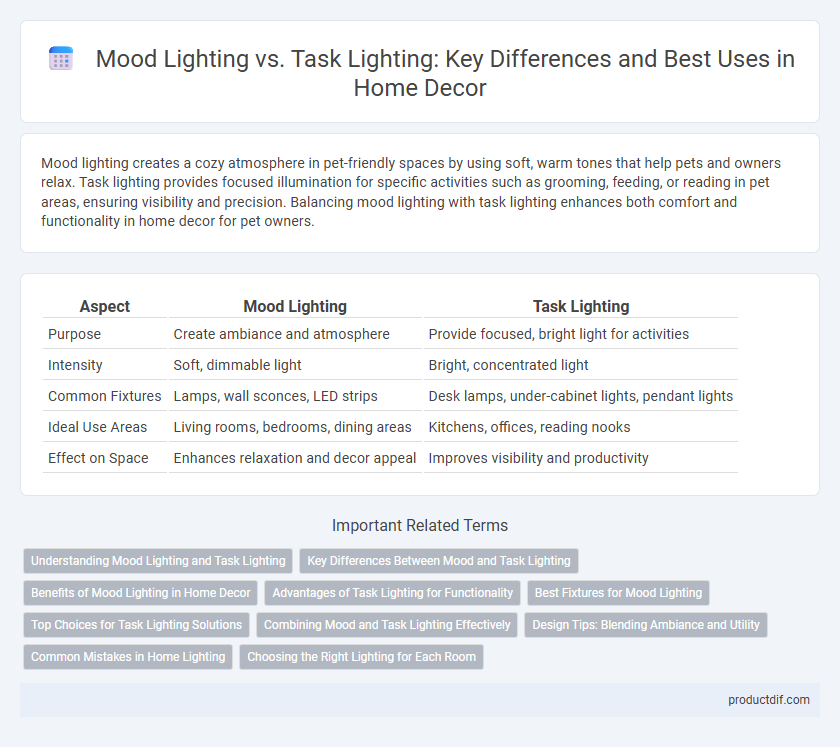Mood lighting creates a cozy atmosphere in pet-friendly spaces by using soft, warm tones that help pets and owners relax. Task lighting provides focused illumination for specific activities such as grooming, feeding, or reading in pet areas, ensuring visibility and precision. Balancing mood lighting with task lighting enhances both comfort and functionality in home decor for pet owners.
Table of Comparison
| Aspect | Mood Lighting | Task Lighting |
|---|---|---|
| Purpose | Create ambiance and atmosphere | Provide focused, bright light for activities |
| Intensity | Soft, dimmable light | Bright, concentrated light |
| Common Fixtures | Lamps, wall sconces, LED strips | Desk lamps, under-cabinet lights, pendant lights |
| Ideal Use Areas | Living rooms, bedrooms, dining areas | Kitchens, offices, reading nooks |
| Effect on Space | Enhances relaxation and decor appeal | Improves visibility and productivity |
Understanding Mood Lighting and Task Lighting
Mood lighting creates an ambient atmosphere using soft, diffused light sources such as dimmable lamps, LED strips, or wall sconces, enhancing relaxation and aesthetic appeal in living spaces. Task lighting provides focused, bright illumination essential for activities like reading, cooking, or working, typically achieved with desk lamps, under-cabinet lights, or adjustable fixtures. Understanding the balance between mood lighting and task lighting is crucial for designing functional and inviting home environments that cater to both comfort and productivity.
Key Differences Between Mood and Task Lighting
Mood lighting enhances ambiance through soft, diffused illumination that creates a warm and inviting atmosphere, often using dimmers or colored bulbs to influence emotional response. Task lighting provides focused, bright light designed to improve visibility and reduce eye strain for activities such as reading, cooking, or working, typically employing adjustable fixtures like desk lamps or under-cabinet lights. The key differences lie in their purpose, intensity, and placement: mood lighting prioritizes aesthetic and comfort, while task lighting prioritizes functionality and precision.
Benefits of Mood Lighting in Home Decor
Mood lighting enhances home decor by creating a warm and inviting atmosphere that elevates the overall ambiance of any room. Soft, diffused light sources reduce harsh shadows and eye strain, promoting relaxation and comfort in living spaces. Versatile fixtures such as dimmable lamps and LED strips allow homeowners to customize lighting levels, enhancing aesthetic appeal while complementing furniture and color schemes.
Advantages of Task Lighting for Functionality
Task lighting enhances functionality by providing focused illumination that reduces eye strain and improves accuracy in activities such as reading, cooking, or crafting. It creates a well-defined area of light, enabling better visibility and precision, which is essential for tasks requiring attention to detail. Unlike mood lighting, task lighting supports productivity and safety through targeted, adjustable brightness tailored to specific needs.
Best Fixtures for Mood Lighting
Mood lighting enhances ambiance through soft, diffused light that creates a warm and inviting atmosphere, utilizing fixtures like pendant lights with dimmers, LED strip lights, and wall sconces. These fixtures prioritize adjustable brightness and color temperature options, allowing customization to suit various moods and activities. Ideal mood lighting fixtures balance functionality with aesthetics, highlighting textures and architectural features while maintaining a cozy environment.
Top Choices for Task Lighting Solutions
Task lighting enhances productivity by providing focused illumination in work areas such as kitchen counters, home offices, and reading nooks. Top choices for task lighting solutions include adjustable desk lamps, under-cabinet LED strips, and swing-arm wall lamps that offer directional light to reduce eye strain. Selecting fixtures with high color rendering index (CRI) and adjustable brightness ensures optimal visibility and comfort during detailed activities.
Combining Mood and Task Lighting Effectively
Combining mood and task lighting effectively enhances both ambiance and functionality in home decor by layering soft, warm light with focused, bright illumination tailored to specific activities. Incorporating dimmable fixtures and adjustable lamps allows seamless transitions between relaxing atmospheres and productivity zones, optimizing spatial usability. Strategic placement, such as ambient wall sconces alongside desk lamps or under-cabinet lights, maximizes both visual comfort and aesthetic appeal.
Design Tips: Blending Ambiance and Utility
Mood lighting creates a warm, inviting atmosphere through dimmable fixtures and soft hues, enhancing relaxation and aesthetic appeal. Task lighting uses brighter, focused sources like desk lamps or under-cabinet LEDs to improve visibility for specific activities such as reading or cooking. Combining adjustable lighting layers and strategically placing fixtures ensures a seamless balance between ambiance and functionality in modern home decor.
Common Mistakes in Home Lighting
Common mistakes in home lighting include confusing mood lighting with task lighting, which reduces functionality and ambiance. Mood lighting, designed to create a cozy atmosphere, typically involves dimmable fixtures and warm color temperatures, while task lighting requires bright, focused illumination for activities like reading or cooking. Failure to balance these types leads to inadequate light levels and discomfort, highlighting the importance of layered lighting strategies in interior design.
Choosing the Right Lighting for Each Room
Mood lighting creates a warm, inviting atmosphere with soft, diffused light sources like sconces or dimmable fixtures, perfect for living rooms and bedrooms. Task lighting provides focused, bright illumination essential for activities such as reading or cooking, commonly using desk lamps or under-cabinet lights in kitchens and workspaces. Selecting the right lighting involves balancing both types to enhance functionality while complementing the room's aesthetic and purpose.
Mood lighting vs Task lighting Infographic

 productdif.com
productdif.com